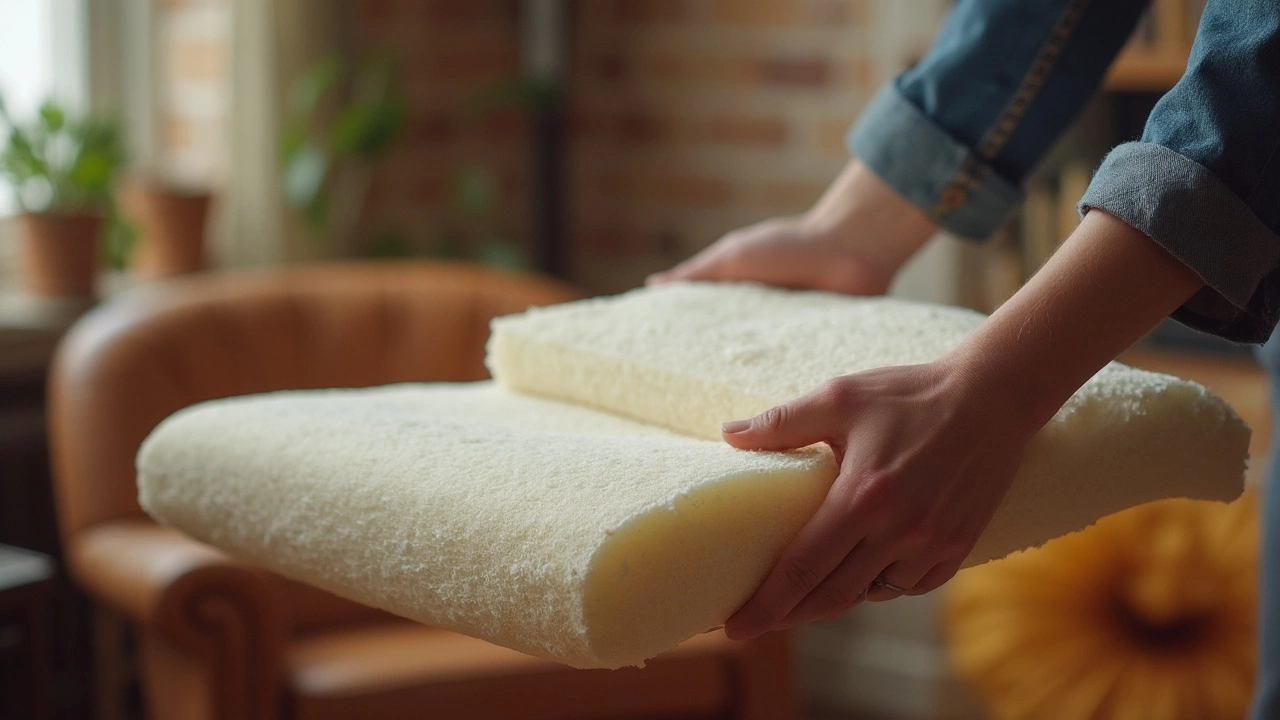Okay, so you're on a mission to find the perfect foam for your sofa, right? But what's the deal with this '32 or 40 density' business? Well, foam density is basically how much matter you’ve got per cubic meter of foam. The higher the number, the more compact it is.
Now, why does this matter for a sofa? Density impacts the feel, durability, and even how long that comfy seat lasts. So, if you've been clocking a lot of movie nights on your couch, density could make a difference in its lifespan.
So typically, 32-density foam is softer and may be what you want for a plush couch cusion. Meanwhile, 40-density foam is firmer, holding up better over time but could feel less cushy.
- Understanding Foam Density
- Comparing 32 and 40 Density
- Comfort and Support Levels
- Cost and Durability Considerations
- Tips for Choosing the Right Foam
Understanding Foam Density
Alright, let's break down what foam density really means when it comes to sofa cushions. Foam density is a measure of how much material is packed into a cubic meter of foam. In simpler terms, it's about how tightly the foam's got its act together.
Generally, the more dense the foam, the heavier it is. This is because there's more core material and less air. So, dense foam usually lasts longer, providing those cozy seats with a longer life. But how does density actually impact your sofa? Here's the lowdown.
Why Density Matters
Density affects the durability and comfort of the foam. A higher density generally means more durability and support. So if you've got a bustling household, a denser foam like a 40 density might keep your sofa in top shape longer.
Density vs. Firmness
Contrary to what many people think, density and firmness aren't the same thing. You might have a high-density foam that’s actually soft or a low-density one that’s firm. Firmness is about how much give a cushion has when you sit on it, while density is about the weight and material packed in there.
Is Higher Density Always Better?
Not necessarily. Higher density comes with benefits like enhanced support and longevity, but it can be pricier. On the flip side, lower density might fit your budget better. It's important to weigh the cost against how long you want your sofa to last.
| Density | Characteristics |
|---|---|
| 32 | Softer, more budget-friendly, suitable for light use |
| 40 | Firmer, more durable, ideal for high traffic use |
Comparing 32 and 40 Density
So, you're torn between 32 and 40-density foam for your sofa cushions, huh? Let's dig into what these numbers mean for comfort, durability, and other factors.
Comfort Levels
When it comes to sinking into your couch after a long day, 32-density foam often feels softer and more giving. It's the kind that wraps you up, making it a hit for those cozy lounging sessions. On the other hand, 40-density foam is a bit firmer, offering better support for your back. It’s not rock-hard by any means, but it has a more structured feel.
Durability
Here’s the kicker: the durability factor. Higher density, like 40, tends to hold its shape for longer, maintaining that new-couch look. If you’re someone who plans to have your couch around for a while, this might be something to consider.
Weight and Usage
Don't forget to think about who's using the sofa the most. Heavier bodies might prefer 40-density foam for that no-sagging-with-time support. But if the couch is a spot for light use, you could save a bit and go with a nice 32 that feels soft and luxurious.
Cost Considerations
Let’s talk cost. Typically, a 40-density option will cost you more upfront. But remember, it could save you in the long term if it means your cushions stand the test of time. So, weigh your budget against how long you want your furniture to last.
To sum it up in a quick visual:
| Density | Comfort Level | Durability | Cost |
|---|---|---|---|
| 32 | Softer | Moderate | Lower |
| 40 | Firmer | High | Higher |
Choosing between a 32 and a 40 isn’t just about a feel; it’s about how you live life on that sofa and what priorities, like cost or durability, matter to you most. Whatever you choose, at least you’re making a choice armed with info!

Comfort and Support Levels
When it comes down to sofa cushions, it's all about the feels, right? Comfort and support are the main players in creating that perfect lounging spot.
Soft vs. Firm
Let's talk about foam density and its impact. A 32-density foam generally offers a softer landing with a cozy feel. It's great for those who like to sink in and relax after a long day. On the other hand, 40-density foam has a more structured feel, perfect if you like to sit upright without sinking too much. It's kinda like comparing a marshmallow to a firm pillow.
So, which one do you go for? If you spend hours binging shows and love to sprawl out, 32 might be your friend. But if you're more about support, maybe working from your sofa, 40 could be the way to go.
Longevity and Wear
Sofas are a big investment. Opting for firms like the 40-density foam can mean your cushions stay in shape longer. Softer foams can lose their bounce quicker under the weight of daily use. This doesn't mean 32-density is bad, though; it just might need a little more regular fluffing.
Mixing Densities
Hey, here's a thought! You can actually mix densities. Some sofas use dual-density combos with firmer foam at the core and softer on top, giving you the best of both worlds. It's like the cushion version of a mullet—business underneath, party on the top!
At the end of the day, finding the right balance comes down to your personal preferences and how you plan to use your sofa. You might even drop by a store to test various densities; trust your butt's judgement!
Cost and Durability Considerations
Alright, let's get real about why you should care about the cost and durability of your sofa cushions. First off, foam density and price are closely connected. You might notice that higher density foams, like 40, tend to cost more. This is because they contain more material, making them heavier and often more durable.
But does spending extra cash mean you’re getting a better deal? Well, here’s the thing: higher density foams are less prone to sagging and can hold their shape longer. Ever sat on a sofa that feels like it’s giving you a hug, but not in the good way? A higher density foam could prevent that. So, while the upfront costs might seem steeper, spending a bit more initially could save you money in the long run by avoiding frequent replacements.
Let’s break it down a bit. Say you bought a 32-density foam cushion, it feels cozy and soft initially, but after a few years of lounging, it starts wearing down. On the flip side, a sofa with 40-density foam might stay firmer and supportive for a longer period.
Crunching the Numbers
Let’s throw some numbers around. A typical sofa foam might last around 3-5 years if it's of lower density. With higher density, like 40, you’re looking at a potential lifespan of 6-10 years or even more if you take good care of it. That's almost doubling the time before you need to think about replacing your cushions!
Here's a quick comparison:
| Density | Average Cost | Expected Durability |
|---|---|---|
| 32 | $20 - $30 per cushion | 3-5 years |
| 40 | $35 - $50 per cushion | 6-10 years |
So, whether you're pinching pennies or in it for the long haul, understanding these details helps make your sofa not just a piece of furniture, but a true investment.

Tips for Choosing the Right Foam
So, you're in the market for the right foam for your sofa, and you're trying to navigate the world of foam density. Here's how to make the smartest choice to get the perfect blend of comfort and longevity.
Consider Your Comfort Level
The feel of your sofa cushions is a big deal. Do you want a softer or a firmer seat? A lower density foam like 32 may feel plush but might not last as long. In contrast, a 40 density offers a firmer seat that can maintain its shape over the years.
Think About Usage
How much action does your sofa see? If it's in the family room and everyone, including the dog, claims a spot, you might need denser foam for durability. For a more decorative piece that doesn’t see much traffic, a softer option might be fine.
Balance Cost vs. Lifespan
Denser foams generally last longer and keep their shape, but they may also come with a higher price tag. Consider how long you plan to use the sofa and whether you're okay with investing a bit more upfront for long-term durability.
Check Maintenance Needs
Cleaning matters! Denser foams can sometimes be easier to maintain because they don't sag as much over time. If your sofa is prone to spills and stains, ease of maintenance is something you should definitely think about.
Test It Out
If possible, head to a store and literally take a seat. Feel it out, jump around—a few bounces won't hurt! Testing could give you a physical sense of what different densities offer.
A Few Handy Numbers
To put things in perspective, look at a quick comparison:
| Foam Density | Expected Lifespan (years) |
|---|---|
| 32 | 3-5 |
| 40 | 5-7 |
These are general ranges, of course, but they give you an idea of what to expect.
Choosing the right foam for your sofa means considering comfort, usage, cost, and even the feel your whole household loves. So, take your time, test things out, and find something that gives you a perfect seat every time!
 EN
EN
 HR
HR
 AR
AR

